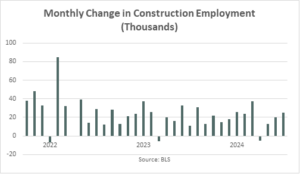by Arsene Aka, Senior Economist at Dodge Construction Network
The latest data released by the Bureau of Labor Statistics (BLS) shows that the U.S. labor market deteriorated in July. Missing expectations, hiring slowed to 114,000 jobs last month, below the average monthly gain of 218,000 recorded over the prior six months. In addition, previously released jobs data for May and June were revised down by a combined 29,000. It is worth noting that the July payroll figure has been partially impacted by Hurricane Beryl, which made landfall in Texas on July 8. Meanwhile, the jobless rate jumped to 4.3%, its highest since October 2021, as more individuals entered the labor force. Growth in the average hourly earnings for all U.S. employees on private nonfarm payrolls eased to 3.6% year-over-year last month, from 3.8% in June and 4.0% in May.
Wage growth in the construction industry also eased, from 4.8% in June to 4.3% a month later, but remained above the nation because of persistent labor shortages. Unlike the nation, employment in the construction sector has increased since May, with new job gains standing at 20,000 in June and 25,000 in July. Construction employment has averaged 19,000 over the prior 6 months. In July, employment growth was broad-based across all construction categories, with the largest gain occurring in nonresidential specialty trade contractors (11,300), followed by residential specialty trade contractors (7,400) and heavy and civil engineering (2,900). The industry’s jobless rate rose from 3.3% in June to 3.9% last month, remaining well below the rate of 7.0% recorded in February.
The softening in U.S. wage growth and weakness in the labor market, along with the unexpected rise in unemployment claims and a further weakening of the manufacturing sector, have renewed fears that the Federal Reserve may be waiting too long to start cutting interest rates. The latest employment report confirms Dodge Construction Network’s outlook that a rate cut is coming in September. Dodge also expects the Fed will deliver another rate cut in December and then in every quarter until the target rate reaches 3% in late 2026. Consequently, Dodge continues to expect robust construction employment growth rates over the next two years.

